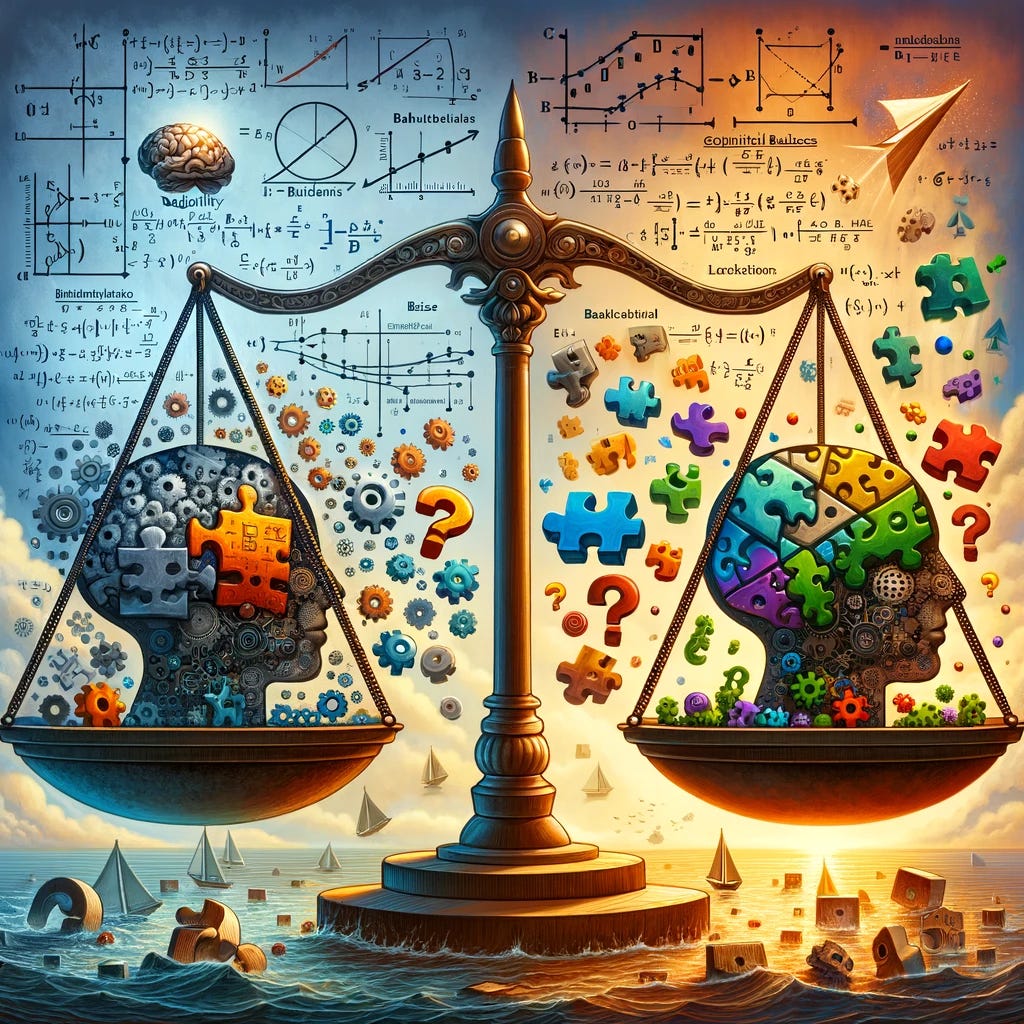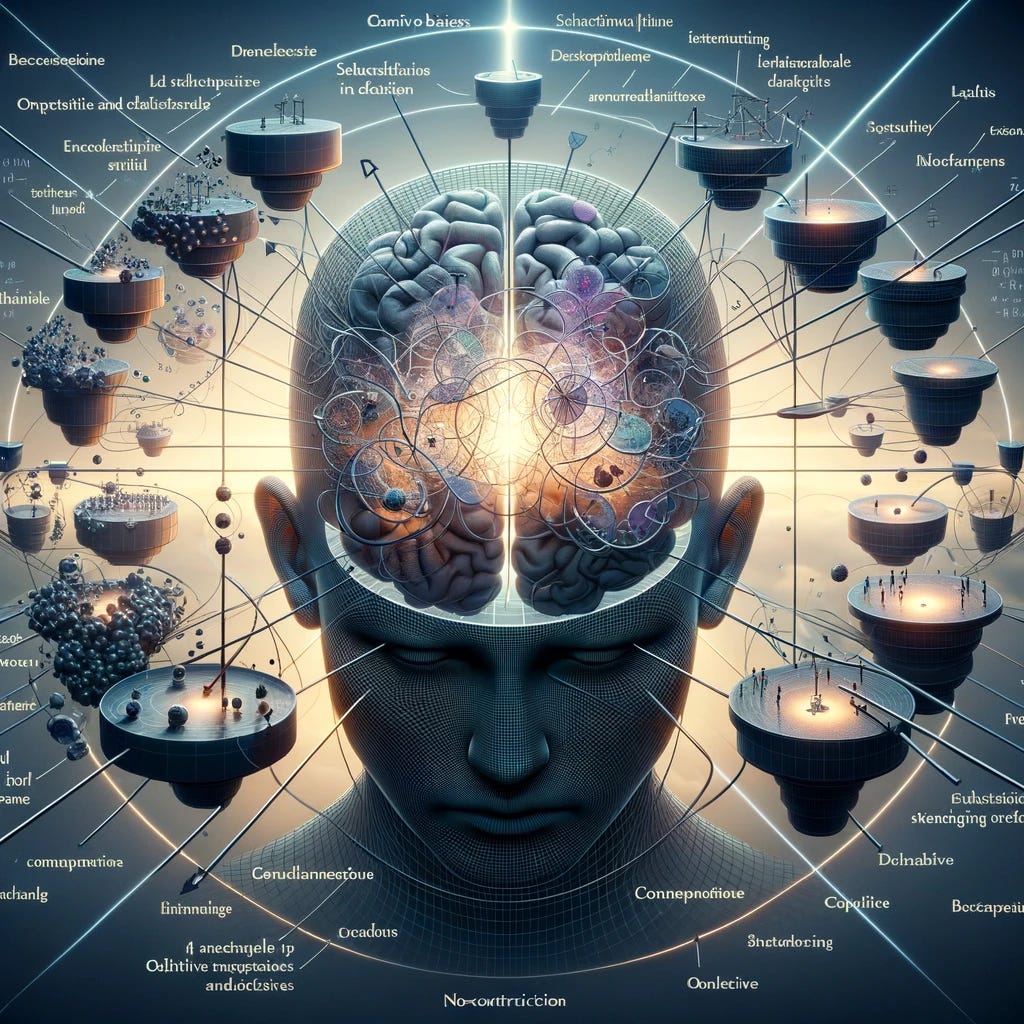How we ALL think
Bridging Rationality and Cognitive Biases
by Joseph Mark Haykov
March 11, 2024-03-11
Abstract
In mathematical economics and game theory, the axiom of rational utility (or payoff) maximization is foundational, informing critical theoretical frameworks like Nash equilibria, the welfare economics theorems, and the Arrow-Debreau model. These frameworks rest on the assumption that consumer behavior is driven by the rational maximization of utility, an assumption supported by the persuasive power of financial incentives. Yet, the persistence of cognitive biases in empirical observations poses a significant challenge to the notion of objective rationality, raising concerns about the real-world applicability of these economic theories. Notably, the Federal Reserve Bank of the United States, which shapes economic policy based on insights from mathematical economics, relies on the accuracy of these models. Inaccuracies in foundational assumptions could thus have profound implications for policy effectiveness.
This paper introduces an innovative mathematical framework that seamlessly integrates cognitive biases into economic behavior models without discarding the premise of rationality. By refining conventional models to include systematic behavioral deviations, we strive to harmonize the empirically evident irrationalities of human decision-making with the theoretical pillars of economic and game theory. This methodology not only bolsters the models' realism and practical relevance but also enriches our comprehension of how rationality and cognitive biases interact to influence economic behavior. Through this integration, the paper contributes to a more nuanced and applicable economic theory, addressing the gap between theoretical assumptions and real-world economic dynamics.
Bridging Worlds: The Philosophical Journey from Abstract Axioms to Empirical Realities in Mathematics
Mathematical game theory, similar to other domains such as linear algebra or Zermelo-Fraenkel (ZF) set theory, begins by establishing axioms as foundational truths. From these axioms, theorems are logically derived, serving as immutable truths within their axiomatic framework. These theorems, bastions of logical certainty, maintain their veracity through deductive reasoning, provided their foundational axioms are applicable. This reveals a nuanced truth about mathematical theorems: they are unconditionally true within their theoretical domain yet conditionally true when applied to the empirical world.
Consider the Pythagorean theorem, a cornerstone of Euclidean geometry, based on the axiom that the shortest distance between two points is a straight line. However, this axiom assumes a flat, uncurved space—a condition contradicted by the complexities of our universe, where spacetime is curved by mass and energy. The empirical fact of spacetime curvature, validated by Einstein's theory of general relativity, necessitates a shift from Euclidean to Riemannian geometry for an accurate description of the universe. Riemannian geometry, which accommodates the curvature of spacetime, lays the groundwork for a true understanding of the universe's geometric nature.
This transition from Euclidean to non-Euclidean geometries, such as Riemannian geometry, does not detract from the objective truth of mathematical theorems but emphasizes the importance of selecting the appropriate mathematical model to describe reality. Einstein's observations, particularly the relativistic effects on time and space observed through technologies like GPS, empirically affirm spacetime curvature. These phenomena illustrate not a theoretical conjecture but a tangible reality—the shortest path between two points in our universe is not a straight line, but a curve shaped by the fabric of spacetime itself.
Within the structured realm of their axiomatic systems, mathematical theorems stand as unwavering truths. Yet, when extended to the tangible world, their truth becomes conditional, reliant on the fidelity of those foundational axioms to the physical universe. This delineation between the irrefutable truth of theorems within their theoretical sanctuary and the empirical truth of theoretical assertions in applied mathematics underscores a pivotal philosophical principle. The latter demands that the axioms not only serve as theoretical constructs but also resonate with tangible reality, ensuring the derived conclusions retain their truth in a world far more complex than abstract models suggest.
This dual criterion for truth in applied mathematics highlights the delicate balance between selecting axioms that are both theoretically sound and empirically valid. By recognizing the limitations of our mathematical models in perfectly capturing the nuances of the physical world, mathematics does not diminish its value; rather, it enhances its capacity to offer profound insights into the fabric of reality. Through this meticulous process of axiom selection and theory adaptation to better mirror the universe, mathematics remains a pivotal tool in our quest to understand the world around us.
The Interplay of Rationality and Logic: Insights from Mathematical Reasoning
In this section, we shift our focus strictly to the factual underpinnings of rationality, bypassing theoretical or philosophical conjectures. Rationality, as commonly understood, is reflected in the formal methodologies employed in mathematical proofs. Every such proof relies on applying both deductive and inductive reasoning to a foundational set of axioms, setting the stage for further logical assertions, like Fermat's Last Theorem, to be recognized as unequivocally true, contingent on the axioms' validity.
The significance of Gödel's second incompleteness theorem cannot be overstated in this context. Gödel unveiled that no system of axioms complex enough could attest to its own consistency, indicating that while we can derive truthful statements using inductive and deductive reasoning from these axioms, the comprehensive consistency of these axioms, along with their resultant theorems, cannot be internally verified. Mathematicians tackle this predicament by adhering to the principle of non-contradiction, methodically excluding any contradictions that arise among new deductions, established axioms, and verified theorems. This process of manual validation is essential for maintaining the coherence and integrity of the mathematical framework.
Preventive measures, such as the prohibition of division by zero in algebra to avoid logical contradictions, exemplify these critical manual safeguards. Such interventions are vital in ensuring the logical robustness and coherence of mathematical reasoning.
We argue that this structured, algorithmic approach, predicated on deductive reasoning and the unwavering principle of non-contradiction, closely aligns with the processes of rational thought. This mode of reasoning, fundamental to the concept of rationality, becomes objectively verifiable. Inductive reasoning allows us to recognize and extrapolate patterns, like the consistent cycle of sunrise and sunset, predicting their continuation. Similarly, deductive logic, inspired by principles of causality—exemplified by Newton's third law, which posits that every action triggers an equal and opposite reaction—employs if-then logic to draw conclusions. The principle of non-contradiction upholds our rational understanding of reality, ensuring no theoretical claims contradict one another, thus maintaining the system's consistency.
An axiomatic system, be it in mathematics or our subjective models of comprehension, cannot provide an accurate representation of reality if it is beset by internal inconsistencies or contradictions with observable evidence. At an individual level, we naturally recognize this limitation, prompting us to reject any logical assertions that conflict with the foundational axioms or previously derived theorems that constitute our personal logic's cornerstone.
Claim Ring: A Metamathematical Abstraction of Rationality
Throughout history, the twin pillars of induction and deduction have been fundamental to mathematical inquiry, playing a critical role in the development of proofs. The enduring significance of these methodologies is epitomized by Euclid's demonstration of the infinite number of prime numbers, a proof that combines deductive reasoning with the underlying notion of an infinite sequence of integers—a concept later formalized by Peano's fifth axiom, the principle of induction. Such milestones emphasize the vital role of induction and deduction, framed within a rigorously enforced principle of logical non-contradiction, enabling Euclid to reveal the contradiction inherent in the assumption of a finite number of primes.
In the unfolding narrative of mathematical progress, the "Logical Claim Ring" emerges as a metamathematical paradigm shift, extending beyond the confines of conventional algebraic rings and fields. This novel framework eschews numerical operations in favor of logical operations, starting from a core set of axioms. It evolves by incorporating theorems that are logically derived from these axioms, employing the recursive application of induction and deduction. This methodology, echoing the operations of addition and multiplication found in algebra, adheres strictly to the principle of non-contradiction. This principle ensures that no theorem—or claim—that contradicts any existing element within the ring is admitted, thus safeguarding the logical integrity and consistency of all theorems within the ring. This mechanism mirrors the organic growth of mathematical knowledge, reflecting the discipline's inherent accumulation of truths.
By situating the "Logical Claim Ring" at this juncture, we redefine the landscape of mathematical thought, blending the precision of logical reasoning with the structural beauty of algebraic operations. This alignment not only underscores the logical consistency essential to mathematical discovery but also illuminates a path forward for the exploration and categorization of knowledge within this rigorous framework. The Logical Claim Ring, therefore, stands as a testament to the evolving dialogue between the abstract and the concrete, the theoretical and the practical, in our quest to understand the underpinnings of mathematical reality.
The development of the Logical Claim Ring not only echoes the empirical progression seen in the body of proven mathematical theorems but also represents a substantial leap in our conceptual grasp of logical reasoning and its application within mathematical proofs. By redefining traditional algebraic operations as vehicles for logical growth and consistency, the Logical Claim Ring provides a fresh perspective for investigating the complex relationship between logic and mathematics. This groundbreaking approach challenges established norms and paves the way for new lines of inquiry, underscoring the dynamic and ever-evolving character of mathematical investigation and its fundamental dependence on logical structure and expansion.
Gödel's Legacy and the Automation of Consistency in Game Theory
In embracing Gödel's insights, we confront the challenge that ensuring non-contradiction—a cornerstone of system coherence—demands hands-on management, resisting full automation within an axiomatic framework. This reality echoes the manual safeguard against division by zero in algebra, a rule instituted to avert logical discrepancies. However, within the specialized realm of mathematical game theory, where the universe of claims in a Logical Claim Ring remains finite, the task of preserving consistency becomes tractably automated. This capacity for automation not only facilitates the modeling of human behavior with unparalleled mathematical precision but also guarantees the internal consistency of our theoretical constructs.
While Gödel's first incompleteness theorem reminds us of the inherent limitations in constructing a complete model of human actions, it simultaneously opens a door to ensuring that our necessarily incomplete models stand on rigorously consistent theoretical ground. Particularly in game theory, where inductive reasoning is less prevalent, and the set of claims is inherently finite, we achieve absolute, provable accuracy in our models—at least in theory. This finite nature allows for the automated verification of consistency, sidestepping the infinite regress that Gödel's theorems caution against in more expansive systems.
This methodical validation of theorems within the Logical Claim Ring reflects the real-world practices of mathematical proof, proposing an innovative framework for delving into logical reasoning and the organization of knowledge. By intertwining abstract algebraic principles with the nuanced processes of logical reasoning, the Logical Claim Ring charts new territories in the exploration and systematization of mathematical knowledge. It celebrates mathematics' ongoing evolution, recognizing it as both an art form and a scientific discipline. Through this lens, the Logical Claim Ring not only enhances our understanding of mathematical and logical reasoning but also underscores the potential for significant advancements in how we conceptualize, model, and apply the foundational principles of mathematics in addressing complex theoretical and practical challenges.
Rationality in Game Theory: The Role of Subjective Claim Rings in Modeling Strategic Behavior
This groundbreaking innovation not only advances our understanding of mathematics but also sheds light on the intricate relationship between algebraic operations and logical reasoning. It represents a significant leap forward in our conceptual grasp of mathematics, broadening our perspectives on its core essence and the potential for new avenues of exploration. Crucially, this innovation plays a pivotal role in enabling precise modeling of human rationality within the realm of mathematical game theory.
Mathematical game theory, deeply rooted in the principles of praxeology, asserts that human actions are purposeful rather than random. Within this framework, individuals—referred to as 'players'—are assumed to engage in rational behavior, driven by the objective to maximize their payoffs. This optimization of personal benefit or utility is pursued within the constraints of the game's rules. Hence, each human being is conceptualized as a rational actor strategically seeking to maximize their payoff given the game's parameters.
Building on this foundation, we propose that rationality, in the context of game theory, can be further understood through the lens of individual "subjective claim rings." Each player operates with a unique set of axioms within their claim ring, from which they logically deduce their game strategies using deductive reasoning. This approach to decision-making is consistent across rational individuals, with notable exceptions being those whose capacity for rational deduction may be compromised, such as very young children, individuals with significant mental impairments, or those experiencing severe cognitive decline.
Therefore, rationality in game theory emerges as a systematic truth, characterized by logical consistency and predictability, except in instances where mental capacity is notably diminished. By integrating the concept of the Logical Claim Ring with game theory, we gain a more precise tool for modeling the strategic thinking and behavior of rational actors. This model underscores the systematic nature of rationality in strategic decision-making, barring the occasional deviations due to unique cognitive limitations.
Decoding Cognitive Biases Through Subjective Claim Rings: A Mathematical Approach
One of the most compelling aspects of employing subjective claim rings, each initially seeded with distinct core axioms, lies in their capacity to model cognitive biases with remarkable mathematical precision. At the heart of this approach is the steadfast adherence to the mathematical principle of non-contradiction, which sheds light on a wide array of cognitive biases directly. This principle elucidates the mechanisms behind biases such as theory-induced blindness, confirmation bias, anchoring bias, among others, by explicating how once beliefs—or theorems—are assimilated into an individual's subjective claim ring, any contradicting claims are inherently precluded from consideration. This phenomenon aligns closely with the essence of theory-induced blindness, where existing convictions occlude the recognition or acceptance of conflicting information.
The subjective claim ring framework elegantly captures the cognitive process where individuals, consciously or subconsciously, filter information through the lens of their pre-established axioms. This filtering process, governed by the non-contradiction principle, ensures that only those new claims or pieces of information that harmonize with the existing set of beliefs are incorporated. Consequently, this mathematical model provides a structured explanation for why individuals might persistently hold onto their biases, rejecting contradictory evidence, and thereby illustrating the persistence of cognitive biases in shaping human perception and decision-making.
By leveraging the mathematical rigor of subjective claim rings to model cognitive biases, we unlock a powerful analytical tool that not only dissects the logical underpinnings of these biases but also offers insights into their pervasive influence on human reasoning. This approach not only deepens our understanding of the structural aspects of cognitive biases but also highlights the potential for developing strategies to mitigate their impact on decision-making. The application of subjective claim rings to cognitive biases exemplifies the synergy between mathematical principles and psychological phenomena, offering a novel perspective on the complexities of human cognition and behavior.
Harnessing Subjective Claim Rings for Effective Nudging: Insights from Behavioral Economics
The concept of subjective claim rings not only enhances our understanding of cognitive biases but also opens up innovative avenues for applying nudging strategies, as demonstrated by the field of behavioral economics. These strategies are designed to guide people towards making certain decisions in a subtle, often subconscious manner. A prime example is the exploitation of the anchoring bias, which is deeply ingrained in the claim rings of many individuals. This bias reflects a preference for the familiar and a reluctance towards change, attributed to the mental effort and potential lack of immediate benefits that change entails.
Recognizing the anchoring bias within claim rings illuminates why certain nudging strategies are so effective. For instance, modifying employment application processes to make insurance enrollment an opt-out rather than an opt-in choice capitalizes on this bias. Since the anchoring bias predisposes individuals to maintain the status quo, the likelihood of employees purchasing insurance increases significantly under an opt-out system. This shift does not merely work in theory; it has been validated by numerous successful implementations of nudging strategies across various contexts.
By integrating the concept of subjective claim rings with the practical application of nudging strategies, we leverage a profound understanding of human psychology to influence behavior in predictable ways. This method acknowledges the presence of anchoring bias and other cognitive predispositions within individuals' decision-making frameworks, using these insights to craft interventions that naturally encourage desired outcomes. The success of such nudging strategies in practice underscores their effectiveness in real-world applications, offering a potent tool for behavior modification that is both subtle and impactful.
The Praxeological Axiom and Its Role in Modeling Rationality: Insights from Game Theory and Economics
At the core of both mathematical game theory and mathematical economics lies the praxeological axiom of human action, which posits individuals as rational utility maximizers. This foundational assumption is crucial for the derivation of mathematical theorems that seek to model and predict human behavior accurately. The accuracy of these theorems, and their ability to reflect real-world scenarios, hinges entirely on the validity of the rational utility maximizer axiom in the given context.
Theorems derived under this axiom are poised to offer accurate representations of reality, assuming their logical progression from the premise of rational utility maximization remains unbroken. The only scenario in which these conclusions might falter is when the axiom itself does not apply systematically—when the assumption of rational utility maximization is fundamentally compromised. For instance, the predictive power of mathematical game theory might wane in environments like an insane asylum, where the premises of rational behavior and utility maximization are not reliably present.
In environments where the principle of rational utility maximization is a consistent norm, the constructs of game theory and mathematical economics demonstrate a remarkable robustness. This steadfastness is maintained even when confronted with unusual deviations from what might be considered objective rational behavior. Such deviations, as seen in the actions of historical figures like Joan of Arc, challenge the conventional understanding of rational utility maximization. Joan's choices, while seemingly contrary to the objective maximization of personal utility, made rational sense within the context of her own subjective claim ring. This distinction underscores the absence of any indication that Joan of Arc's decisions stemmed from a diminished mental capacity. Instead, her actions exemplify the capacity of the subjective claim ring model, each subjective logical claim ring seeded with a different set of axioms, to accurately account for and explain human behavior, bridging the gap between theoretical constructs and real-world actions.
These idiosyncratic deviations, though rare, do not undermine the overall efficacy and accuracy of game theory and economic models. Instead, they underscore the theory's inherent flexibility in accommodating individual exceptions without compromising its general applicability or predictive capability. This adaptability not only enhances the robustness of these theoretical frameworks but also affirms the subjective claim ring model's powerful role in explicating the nuances of human decision-making. By recognizing the subjective rationality of individual actors, even when it diverges from objective rational utility maximization, these models offer profound insights into the complexity of human actions and motivations.
Strategic Equilibrium and Honesty in Cryptocurrencies: A Game Theory Perspective
The subjective claim ring model thus emerges as a pivotal tool in the modeling and explanation of human behavior. It adeptly navigates the delicate balance between theory and reality, providing a nuanced understanding of how personal axioms and subjective rationality can influence decision-making processes. This approach validates the significance of subjective perspectives in economic and game theoretic analyses, acknowledging the diversity of human rationality and its impact on theoretical predictions.
In the realm of game theory, the validity of models built on the rational utility maximization axiom remains robust, even when confronted with individual deviations from objective rationality. This enduring robustness can be largely ascribed to the principle of Nash equilibrium. Nash equilibrium ingeniously ensures the stability of strategic interactions by making it so that any unilateral deviation from a rational strategy does not yield additional benefits, effectively neutralizing the impact of idiosyncratically irrational actions. This concept finds a particularly compelling application in the cryptocurrency domain, where adherence to honesty is inherently incentivized as the dominant strategy by the system's design.
Cryptocurrencies, through their 'rules of the game,' inherently promote honesty as the most rational course of action. This is because the technological and structural features of blockchain technology make any attempt at dishonest behavior, such as fraud or theft, not only detectable but also unrewarding. The mechanism ensures that any deviation from honesty—such as attempting to alter the blockchain in a fraudulent manner—is systematically disadvantaged. Consequently, rational actors within the cryptocurrency system are dissuaded from pursuing strategies that diverge from honesty due to the lack of real-world incentives for such behavior.
Thus, the principle of Nash equilibrium offers a profound insight into the dynamics of strategic decision-making, demonstrating how systems can be designed to encourage desired behaviors among participants. In the context of cryptocurrencies, this translates to a system where the equilibrium favors honesty, with the technology itself enforcing compliance with rational, utility-maximizing behavior. The ingenious alignment of individual incentives with collective security and integrity exemplifies the practical applicability of Nash equilibrium in maintaining the stability of strategic outcomes, showcasing the deep interplay between game theory, technology, and human behavior.
Ensuring Honesty in Cryptocurrencies: The Role of Game Theory and Cryptographic Security
The principle of honesty within the cryptocurrency ecosystem, particularly evident in Bitcoin transactions, transcends mere theoretical discussion to become a practically inescapable reality. This phenomenon is starkly underscored by the fact that approximately 30% of all Bitcoins are believed to be irretrievably lost due to their owners losing their private keys. This significant statistic underscores the non-negotiable requirement of holding the corresponding private key to conduct transactions, thereby deeply embedding honesty within the system's operational ethos.
The system's design, wherein only transactions digitally signed with the private key that corresponds to the wallet’s public key are recognized as valid by the network, effectively ensures that only the private key holder can access the funds within a wallet. This stringent requirement achieves absolute information symmetry across the network, empowering all participants to independently verify the authenticity of transactions. As a result, rational actors within the network are predisposed towards honesty, since any deviation from this principle fails to provide any advantageous outcomes.
Efforts to undermine this system, such as attempts to disseminate a fraudulent version of the Bitcoin blockchain, are inevitably unsuccessful in disturbing the established equilibrium. The resilience of this system is evident across both theoretical frameworks and the empirical realities of cryptocurrency operations, wherein the security and integrity of transactions are consistently preserved. The Nash equilibrium's capacity to maintain stability, even when confronted with idiosyncratic challenges to the system, underscores the applicability of game theory models in accurately capturing the dynamics of strategic interactions among rational actors within complex and technologically advanced settings like those of cryptocurrencies.
This harmonious integration of game theory's strategic analyses with the cryptographic safeguards fundamental to cryptocurrencies such as Bitcoin represents a compelling realization of theoretical concepts in addressing real-world technological challenges. It underscores the predictive precision and reliability of game theory models in characterizing the behavior of rational actors, validating the system's intrinsic inclination towards promoting honesty as the dominant strategy.
The enduring stability of the Nash equilibrium, resilient even amidst deviations from standard notions of rationality, accentuates the intricate design of cryptocurrency systems and the efficacy of game theory in forecasting the outcomes of strategic interactions among rational entities.
Bridging Theory and Reality: The Empirical Validation of Game Theory Models
The theoretical underpinnings of game theory and economics gain substantial support from a diverse range of empirical evidence, which includes the successful application of nudging techniques and impactful marketing campaigns. The DeBeers diamond campaign serves as a quintessential example, effectively instilling the perception of diamonds as both rare and invaluable. This marketing strategy cleverly associates the gifting of diamonds with expressions of love and commitment, positing that the act of giving a diamond is a direct reflection of a suitor's dedication and willingness to part with significant resources. Such strategic messaging considerably boosts the perceived value of diamonds, showcasing the influence of marketing in molding consumer perceptions and desires.
This concrete evidence is further augmented by seminal psychological research, such as the Milgram obedience experiments and the Stanford prison experiments. These investigations not only validate the practical implications of the rational utility maximizer postulate but also explore the significant impact that alterations to 'the rules of the game' exert on human behavior. The unexpected findings from these studies—demonstrating how variations in context can catalyze behavioral shifts—offer solid backing for the axiom's predictive reliability in everyday social environments.
Together, these examples of empirical validation—ranging from strategic consumer perception manipulation to methodical psychological experiments—emphasize the real-world applicability and relevance of game theoretical and economic models. They illustrate the profound effect environmental modifications or changes to 'the rules of the game' can have on human actions, affirming the accuracy of these models in forecasting behaviors across a wide array of social situations.
Moreover, the acknowledgment of exceptions, such as Joan of Arc, along with the durability of concepts like the Nash equilibrium in resisting irrational deviations, highlight the adaptability and predictive precision of mathematical game theory and economics. These disciplines provide intricate models that skillfully account for human behavioral diversity, delivering insightful analyses of decision-making processes and the complexities of social interactions.
This accumulation of evidence reinforces the notion that, in scenarios where rational utility maximization is a standard behavioral norm, the theoretical frameworks predicated on this axiom can yield highly accurate and empirically verifiable predictions of human conduct. Thus, the rational utility maximizer axiom acts as a vital link between abstract mathematical theories and the tangible dynamics of human behavior, enhancing our understanding of decision-making processes and the interplay of human interactions. It reveals the deep synergy between theoretical principles and their manifestations in the real world.
Falsifiability and Practical Utility: Reframing Scientific Validation
Karl Popper's principle of falsifiability establishes a critical standard within the philosophy of science, delineating scientific theories from nonscientific propositions. He asserts that a theory is scientifically valid if it offers empirically testable predictions that are inherently refutable. This principle has garnered acclaim for its direct approach to validating scientific inquiry, emphasizing the necessity of empirical testability for a theory to hold scientific merit.
The term 'scientific' can often seem complex and overused, prompting a shift towards a more accessible and practical terminology. Instead of merely labeling a theory as 'scientific,' assessing it based on its practical utility provides a clearer measure of its significance. For a theory to be practically useful, it must accurately predict future outcomes. Without this predictive capacity, a theory is rendered ineffective. Conversely, a theory capable of making predictions is naturally falsifiable, as these predictions are subject to potential disproof. Hence, from a pragmatic viewpoint, a theory's value is fundamentally linked to its falsifiability, resonating with Popper's belief that this characteristic is vital for both its practical utility and scientific validity.
This shift towards valuing real-world applicability over academic definitions reimagines how scientific merit is evaluated. By concentrating on a theory's practical value as a testament to its scientific integrity, we embrace Popper's philosophy that a theory's real-world utility is deeply connected to its falsifiability. This streamlined approach ensures that scientific exploration remains anchored in empirical testability and practical relevance.
Popper's emphasis on empirical testability and falsification underscores a key scientific method principle: a discrepancy between a theory's predictions and empirical observations signals an error in its foundational assumptions. Through identifying and correcting this error, we enhance our collective understanding of the natural world. This cyclical process of hypothesis testing, falsification, and theoretical refinement is fundamental to scientific advancement, guaranteeing that our investigation of natural phenomena is methodical and empirically grounded.
Theories amenable to falsification integrate seamlessly into logical claim rings, where theoretical assertions are logically deduced from established axioms. The congruence between mathematically derived conclusions and empirical data, assuming the axioms' accuracy, highlights the indispensable role of mathematics in various scientific fields. From the 'hard' sciences, which are naturally amenable to mathematical representation, to the 'soft' sciences, where mathematical models augment predictive accuracy and analytical depth, this methodology instills confidence in theoretical insights, contingent upon the foundational axioms' reliability.
The credibility of these foundational axioms is critical; when they faithfully reflect the laws governing natural and societal phenomena, the resulting models and theoretical assertions become unfailingly reliable tools for deciphering the universe and human society. This axiom-based trust in models' predictive capabilities empowers scientists to anticipate, infer, and innovate, affirming mathematics as the universal language for expressing and unraveling the complexities of our world.
Enhancing Scientific Precision with Logical Claim Rings: A Mathematical Approach
In today's objective scientific landscape, spanning from physics to economics, the logical claim ring methodology is universally applied for developing and evaluating scientific theories. This systematic approach enables the construction of theories through theoretical claims that are logically derived from foundational axioms. These axioms serve as the bedrock of the logical claim ring, with all subsequent theoretical claims bolstered by rigorous mathematical proofs, including induction and deduction, while adhering to the principle of non-contradiction. Consequently, a theory grounded in these axioms is expected to mirror reality accurately, barring instances where empirical evidence directly contradicts one of the axioms. If any claim within a logical claim ring contradicts observed empirical facts, it unequivocally points to a flaw in one or more foundational axioms. In the absence of such contradictions, the derived theoretical claims are deemed to accurately reflect reality, owing to the precise and tautological essence of mathematical proof.
The reliability of mathematically proven claims, hinging on the accuracy of the foundational axioms, allows for an objective comparison of the real-world validity of scientific theories. This analysis leverages the mathematical principle of probability to assess the likelihood of a theory being falsified against all possible outcomes. Notably, when two theories, A and B, encompass all pertinent facts, but B adopts additional assumptions beyond those of A, B is inherently more prone to disproof. This vulnerability arises because errors in shared assumptions affect both theories, whereas errors unique to B's extra assumptions exclusively compromise B, making A a more plausible representation of reality.
Formally, if theory A is based on a subset of axioms underpinning theory B’s claim ring, theory A is more likely to be true than theory B. This conclusion, derived from the mathematical definition of probability, highlights that there are no scenarios where A can be disproven while B stands, yet multiple instances exist where B could be invalidated without affecting A. Thus, logical consistency, empirical validation, and parsimony are essential to the advancement of objective science, anchored in mathematical certainty rather than abstract speculation.
The axiom that the most likely true theory is the one requiring the fewest assumptions aligns with the principle of parsimony, best illustrated by Occam's Razor. This principle suggests that, among competing hypotheses that equally explain the observed phenomena, the one with the least superfluous assumptions should be preferred. This methodology has been immensely valuable in simplifying the complexities of scientific theory, underscoring the importance of empirical testability and conceptual simplicity in achieving scientific accuracy.
The logical claim ring framework unequivocally demonstrates that a theory with fewer assumptions (theory A) invariably surpasses a more assumptive theory (theory B) in terms of accuracy. This definitive advantage, supported by the probabilistic nature of mathematical certainty, affirms Occam's Razor as more than a heuristic; it is a principle reinforced by mathematical validation. Therefore, Occam's Razor ascends beyond its heuristic origins, establishing itself as an indispensable axiom in scientific inquiry, deeply integrated within the realm of mathematical proof.
















